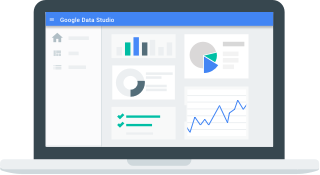
Since Google Data Studio debuted last year, there’s been an incredulous amount of updates and improvements made to the platform day by day. Haven’t used Data Studio yet? Read our post here that gives an overview of the tool, including what it is and how it works.
Now, let’s get started walking through the new updates and features in Google Data Studio, and how you can start using them today to better your reporting strategy.
The New Data Blending Feature in Data Studio

Have you ever combined data outside of Data Studio for a report? Or had dreams of connecting dots between social interactions and traffic data?
Now (finally!) the most important feature of any data visualization software has come to Data Studio.
It’s called Data Blending, you use it to join data from different sources for better dashboards and more in depth reporting.
The new DATA BLENDING feature allows you to connect multiple datasets at a time using a common key.
While not nearly as sophisticated as the Tableau Prep join functionality that calls out mismatched fields, the new interface allows you to select all of the fields you want included from each data sources and connect them seamlessly.

Similar to Tableau, users can now choose to select either a live or extracted data connection.
Why does this matter for reporting?
Well, simply put, it allows for flexibility in data freshness and processing time. A solution to a BIG Data Studio problem: refresh speed (when connecting to multiple types of data sources and/or large sets of data).
For time-bound reports, this is a huge step forward — ensuring Data Studio can be used for more than just live dashboards. Live connections are connected directly to the data so it can access the latest and greatest data with the click of a button, while an extract allows flexibility when working with large data sets where a lot of manipulation is necessary.
Expanded Google Search Console Reporting
Rolled out at the same time as Data Blend, Data Studio will now allow you to pull up to 16 months of GSC data for reporting. This is a huge advancement and allows for larger periods of comparison and less manual process.
If you’re using the Search Console Search Analytics #API, you now have access to all 16 months of data provided in the UI! If you’d like to integrate the data with your CMS or make your own tools, check out our docs athttps://t.co/cqVVyHIbUp
— Google Webmasters (@googlewmc) June 18, 2018
Overall, this is a huge step forward for Data Studio, finally opening up possibilities of deep analysis with multiple data sets. What it still lacks is the ability to clean or transform data as you join it. While you can alter data types or make basic changes, you are not going to be able to manipulate the data the way you would in competing solutions, making actions like removing trailing spaces, or making all text lowercase complicated.
That said, analysis just got easier and we are eager to further test the tool and increased GSC abilities. If you’re into data analysis and love data visualization tools like Tableau, Power BI, and Google Data Studio subscribe below to stay in the know. You can also hit up our YouTube Channel for tutorials and round tables on data visualization. Let us know what you think!